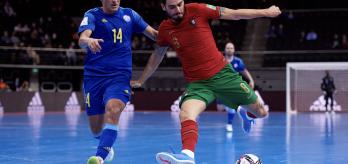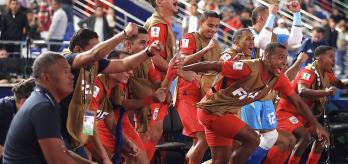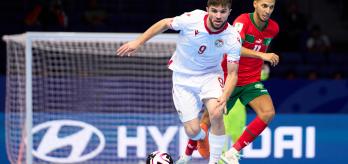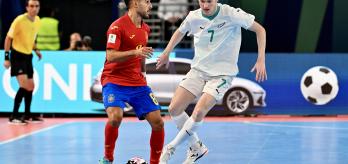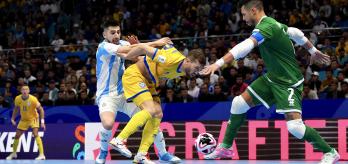The group stage of the FIFA Futsal World Cup Uzbekistan 2024™ showcased an array of star talent, diverse playing styles and dramatic moments. Previous world champions made statements in this first tournament phase, while several other teams produced performances that demonstrated their confidence to compete at the highest level. Below, the Technical Study Group review each group from a technical, tactical and physical perspective. Their observations are accompanied by team dashboards created by FIFA’s Football Performance Analysis & Insights team.
Emerging trends
- The way teams position themselves out of possession is changing. Compared to FIFA Futsal World Cup Lithuania 2021™, tournament participants during the group stage in Uzbekistan were retreating into a low block more frequently.
- Defenders are becoming more proactive in 1v1 scenarios. FIFA’s “commit” metric (which tracks when the defending player makes the first move in a 1v1 situation) for the group stage is almost double that of the 2021 group stage (2.1 commitments per game compared to 0.9 three years ago).
- The group stages showed goalkeepers are becoming increasingly involved in attacking play, with the use of the flying goalkeeper increasing by 49% from 2021.
Group A: Paraguay, Netherlands, Costa Rica, Uzbekistan
Team dashboards are positioned according to final group standings.
Graeme Dell: The group was incredibly open at the beginning. I was not sure what to expect as there were very different styles of play, featuring teams from Latin America, Europe and Asia. The Netherlands were probably the surprise in the group with their performances. Paraguay turned up and played as expected, and proved they could capitalise on their strong possession figures and pass-completion rate. When looking at their team dashboard, Paraguay have a pass-completion rate of 90%. What does that look like in comparison to other Group A teams? 90% compared to the Netherlands’ 83% may not seem like a big gap but in futsal this is significant. Their possession game certainly bared fruit as the group stage went on.
By contrast, Uzbekistan had lots of possession but didn’t really make it pay. They tried to play in a particular style, which is expected from a team coached by Venancio López. However, they never really had that killer instinct. They did have success deploying the powerplay in games one and two, where they got goals back against their opponents, indicating one potential bright spot. Overall though, there were just too many mistakes as a team and demonstrating that possession means little unless you score goals. Costa Rica fought and battled for everything to just about make it through as a third-place qualifier.
Out of the teams that strived to play a solid possession game, it was the ones which have made their possession pay who progressed into the next round. Overall, Paraguay were heads and shoulders above the other three teams. They did however rely on particular players, as one example Adolfo Salas (7) averaged 29 minutes per game on court versus the team average of 14 minutes meaning he’s already had significant amounts of court time compared to others. This could prove detrimental to Paraguay in the knockout phases.
Group A in numbers:
-
41.7 – Costa Rica averaged this number of long balls per game, the highest of any team in the competition so far.
-
20 – Group winners Paraguay averaged 20 take-ons per game, the second highest of all participants.
-
5 – The number of pivot balls Uzbekistan played across their three games. This was the lowest of Group A, and shows the extent Uzbekistan involved the pivot during their campaign.
Group B: Brazil, Thailand, Croatia, Cuba
Ali Targholizadeh: Brazil as leaders of Group B displayed an aggressive type of futsal, scoring 27 goals and conceding two in their group stage matches. They possess a collection of high-quality players with the ability to perform different variations of set plays and pivot plays, with Pito (10) and Ferrao (11) at the heart of the latter. The leadership of captain Dyego (7) and Marcel (6) is also integral. Players can play all positions which means no quality is lost when making flying changes. Thailand showed endeavor, unity and teamwork on their way to finishing runners-up of Group B. In their first match against Croatia, they controlled large spells and were clinical with their goalscoring opportunities, which originated from rapid counter-attacks. Thailand’s quick players, especially pivot Muhammad Osamanmusa (11), proved threating in these situations.
Croatia’s players possessed great physical fitness and sharp technical abilities. Their pivot, Luka Perić (9), and captain, Dario Marinović (8), put in sublime performances against Brazil. In the first period against the eventual group winners, Croatia performed a coordinated high press which stood out, but their performance slipped in the second period. Nevertheless, they managed to qualify as runners-up in the group and face Argentina in the next round. Cuba on the other hand conceded 27 goals and only scored 5, which were all against Thailand. Despite being knocked out though, Cuba players proved themselves skilful with a bright future.
Group B in numbers:
-
159 – Brazil’s attempts at goal in the group Stage. The Group B winners’ tally was the second highest of all teams after the group stage.
-
128 – The number of passes Brazil played as pivot balls. This tournament-high figure emphasises the importance of the pivot to the Seleção’s overall playing style.
-
15 – The most goals scored in a game (Thailand 10-5 Cuba). This game also featured the highest number of counter-attacks (36).
Group C: Argentina, Ukraine, Afghanistan, Angola
Dell: This was a great group consisting of lots of contrasting styles of play. You had the individual brilliance of Angola, the more structured team play of Argentina and the developing side of Ukraine. Then, you had Afghanistan, who few knew what to expect from, possessing an ability to play and a comprehensive understanding of futsal. They had some great technicians in their team as well and we might see even more from them in the round of 16.
The shot accuracy was consistent across the whole group. Argentina’s use of the pivot was impressive. Their use of two very different quads to get out of trouble was also noteworthy, with their second quad coming to the fore against Angola; the former world champions demonstrated they could use their players to the best of their abilities.
Angola bucked the trend in a group where take-ons weren’t exceptionally high. The African team registered and average of 21 per game, the highest of any team so far this tournament. The use of the mid-block was a prominent element of this group, with Afghanistan, Argentina and Ukraine keen advocates of this defensive structure; this partly explains why the tactical role of the pivot didn’t heavily feature in these teams’ in-possession play. Argentina were head and shoulders above the other three teams, with their combative approach – highlighted by their average of 29 tackles per game – demonstrating their offensive superiority.
Group C in numbers:
-
698 – The fewest number of passes in a group stage game (Ukraine v. Afghanistan).
-
37 – The total number of goals scored in Group C. This was joint lowest alongside Group D.
-
21 – Angola averaged 21 take-ons across their three group stage matches, the highest of any team.
Group D: Spain, Kazakhstan, Libya, New Zealand
Carlos Quiros: After a draw in their first match against Kazakhstan, Spain came into their own in their following two games, beating New Zealand and Libya by 7-1 and 8-0 respectively. The Group D winners’ high block caused problems for their opposition and prevented them from developing any sort of play as a collective, leaving no other option than resorting to long balls. New Zealand, for example, averaged 41 long balls per game, with many of these being executed against La Roja. When Spain was in possession, they rotated in 3-1 and 4-0 systems and displayed excellent individual and collective play.
Kazakhstan, who finished second in the group, showed us that the experience of their players gives them great finishing ability, expertise in pivot play and skill in using the flying goalkeeper. Both Spain and Kazakhstan had exceptionally high pass-completion rates (93% and 90% respectively), which indicates the technical acumen possessed by their players and the tactical alignment they have as teams. Although Libya didn’t progress to the next round, their players put in strong individual performances in their victory over New Zealand, but can improve at the collective level. New Zealand are a team that’s currently in development, with their technical and tactical capabilities still in the early stages. The experience of the Futsal World Cup will be an important part of their future development.
Group D in numbers:
-
38.9 – The percentage of Spain’s attempts on target that resulted in a goal. La Roja’s conversion rate was the second best of the group stage.
-
28 – Kazakhstan’s Higuita averaged 28 flying goalkeeper events per match, more than any other keeper so far.
-
21.2 – The percentage of defensive actions completed by Spain. This is the highest by any participant so far.
Group E: Portugal, Morocco, Panama, Tajikistan
Dell: This group ended as expected. Morocco played the way we anticipated they would play. I think they still have a lot more left in the tank and the same applies to Portugal – the current holders are a class above Tajikistan, Morocco and Panama. Every player in Portugal’s squad has a unique quality, meaning they have strength in depth. When they rotate their players, they bring on another team-mate with another set of specialisms and exceptional ability. Looking at the data set, Portugal played a surprising number of long balls. However, if you drill down into those you’ll see a number of these balls are used to break the press. They were particularly good at this, always finding a forward player to relieve pressure from their defensive quarter.
Portugal’s Erick (8) was by far the best player in this group and was instrumental for his team. It will be interesting to see if he’s trying to take the mantle from recently retired Ricardinho. Portugal are demonstrating no weaknesses despite having lost their talisman three years ago: nothing seemed to phase them. Even during phases of games when things weren’t going according to plan, they never flustered and maintained absolute belief in each other and the system they were playing.
Group E in numbers:
-
15 & 12 – The average number of times Morocco used the high block and high press per game. These averages were higher than any other team.
-
3 – The number of fouls Tajikistan won on average per game – the second lowest of the group stage.
-
0 - The amount of times Panama used a counter-press after losing possession. Panama, alongside Guatemala and Libya, are the only teams not to trigger this type of press in the group stage.
Group F: Iran, France, Venezuela, Guatemala
Targholizadeh: IR Iran finished top of Group F with a plus 14 goal difference. On their way to getting nine points, they demonstrated an ability to play in a 4-0 and 3-1 system. IR Iran also possess a variety of set-play routines. At the player level, young talent Salar Aghapour (12) and technician Moslem Oladghobad (8) thrive in 1v1 situations. Futsal legend and team captain Asghar Hasanzadeh (7), who is appearing in his fifth FIFA Futsal World Cup, has also proved a potent attacking threat.
France has shown competence in their first Futsal World Cup. Their team consists of players with high quality and strong physical fitness. In their 6-3 win over Guatemala, they also showed sharp finishing abilities. They continued this in their 7-3 victory over Venezuela in their next game. Standout players include pivot Arthur Tchaptchet (5) and Mamadou Siragassy Touré (3), who has impressive skill and is clinical in front of goal. The depth of their squad is also solid and played an important role in their two victories.
Venezuela’s three points gathered against Guatemala was enough for them to qualify in a third-place spot. They now face two-time world champions Spain. Guatemala are a team of experienced futsal players who narrowly missed out to Venezuela. Despite going home with zero points, they managed to score 12 goals in their three games, indicating their attacking threat and capacity to compete on the world stage.
Group F in numbers:
-
76.9 – The number of take-ons France completed in the group stage. Although they ranked 12th for number of take-ons attempted, Les Bleus’ completion rate is higher than any other team so far.
-
55 – The most goals scored in a group. Group F is also the only group where all teams scored 10 goals or more.
-
30 – The highest number of powerplays in a match (Venezuela v. Guatemala). With both teams desperate for a result in their final group stage game, there was even a moment where both teams activated powerplays at the same time.
Visit the Match Report Hub for more match-specific statistics







